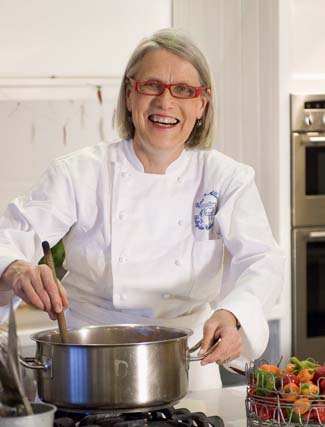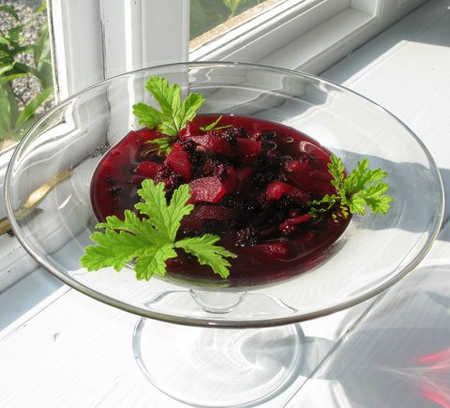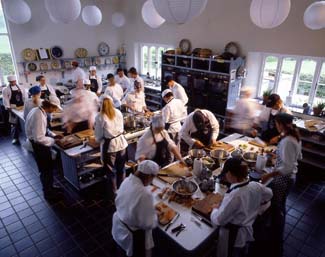The Darina Allen Column

There’s going to be a great crop of blackberries this year, says Darina, and she has some terrific recipes for you to try
Wow, there’s going to be the biggest crop of blackberries this year, so I am gearing myself up for lots of picking expeditions.
We’re also planning a myriad of delicious ways to use them, not just the usual jams, jellies and cobblers, but wine, liqueur and cordials. I’ll throw some blackberries into smoothies and scones and scatter them over a layer of softly-whipped cream to fill a feather-light sponge.
A few juicy berries combined with chunks of ripe melon and shredded mint make a delicious starter and even a dessert.
I’ll also get to make that sublime blackberry trifle I tasted at Dock Kitchen, London, last autumn, or even a simple blackberry and sweet geranium puff. I’m also planning to pop some in the freezer, they keep brilliantly, particularly if one takes the time to tray freeze firstly, before putting them into good strong plastic bags or boxes.
 Blackberries come from the Rubus Genus, the Rosacea family, and there are lots of different strains; some are small, others fat and plump. Apart from being juicy and delicious, they are packed with vitamins, minerals and trace elements. They’ve got lots of fibre and antioxidants and are particularly rich in the healing vitamin C.
Blackberries come from the Rubus Genus, the Rosacea family, and there are lots of different strains; some are small, others fat and plump. Apart from being juicy and delicious, they are packed with vitamins, minerals and trace elements. They’ve got lots of fibre and antioxidants and are particularly rich in the healing vitamin C.
However, they are low in pectin, so jam and jelly makers will need to use jam sugar, unless they combine the blackberries with tart cooking apples or crab apples to increase the acidity.
I am systematically reducing sugar by 20% in all my recipes, because of my observation that the sugar to which we now have access is more intensely sweet than the Irish beet sugar upon which my original recipes were based. However, sugar is the preservative in jams, jellies, cordials et al, so be careful not to reduce too much, or the preserves won’t keep.
Picking tips:
Blackberries should be selected at the peak of ripeness; unlike many other fruits, they don’t continue to ripen after they are picked. Inspect each one as you pick them, the centre should be white and unblemished; if it appears stained or inky, it usually indicates that the fruit has been infected by little worms. It’s worth togging yourself out in jeans, a long-sleeved shirt, and a leather glove to clasp the thorny brambles. When the berries are ripe, they come away easily in your hands.
 Compote of Blackberry and Apples with Sweet Geranium Leaves
Compote of Blackberry and Apples with Sweet Geranium Leaves
Serves about 3 - 4
225g (8oz) sugar
450ml (16fl oz) water
4 large dessert apples eg. Worcester Pearmain or Coxes Orange Pippin
275g (10oz) blackberries
8 large sweet geranium leaves (Pelargonium Graveolens)
Put the sugar, cold water and sweet geranium leaves into a saucepan, bring to the boil for 1-2 minutes.
Peel the apples thinly with a peeler, keeping a good round shape. Quarter them, remove the core and trim the ends. Cut into segments 5mm (1/4 inch) thick. Add to the syrup.
Poach until translucent but not broken. Cover with a paper lid and lid of the saucepan.
Just 3-5 minutes before they have finished cooking, add the blackberries, simmer together so that they are both cooked at once.
Serve chilled, with little shortbread biscuits.
Pan-grilled Duck Breast with Blackberry Colcannon
Serves 4
4 free-range duck breasts
sea salt
Blackberry Colcannon
450g (1lb) Savoy or spring cabbage
900g -1.35kg (2-3lb) ‘old’ potatoes, eg, Golden Wonders or Kerrs Pinks
250ml (8fl oz) approx. boiling milk
25g (1oz) scallion or spring onion, optional
salt and freshly ground pepper
50g (2oz) approx butter
110g (4oz) blackberries
First make the colcannon.
Scrub the potatoes, put them in a saucepan of cold water, add a good pinch of salt and bring to the boil. When the potatoes are about half cooked, 15 minutes approx. for ‘old’ potatoes, strain off two-thirds of the water, replace the lid on the saucepan, put onto a gentle heat and allow the potatoes to steam until they are cooked.
Remove the dark outer leaves from the cabbage. Wash the rest and cut into quarters, remove the core and cut finely across the grain. Boil in a little boiling water or bacon cooking water until soft. Drain, season with salt, freshly ground pepper and a little butter.
When the potatoes are just cooked, put the milk, and the finely chopped scallions into a saucepan and bring to the boil.
Pull the peel off the potatoes and discard, mash quickly while they are still warm and beat in enough boiling milk to make a fluffy puree. (If you have a large quantity, put the potatoes in the bowl of a food mixer and beat with the spade.)
Then stir in the cooked cabbage and taste for seasoning.
For perfection, serve immediately in a hot dish with a lump of butter melting in the centre.
Colcannon may be prepared ahead up to this point and reheated later in a moderate oven 180C/350F/Gas Mark 4, for 20-25 minutes approx. Cover while reheating so it doesn’t get too crusty on top.
Meanwhile score the duck skin into a diamond pattern. Sprinkle lightly with salt. Put a pan grill on a low heat. Cook the duck breasts very slowly and gently for 15-20 minutes on the fat side, by then the fat should be rendered out (pour off the excess and save for duck confit) and the skin will be crisp and golden.
Season the flesh side with sea salt and turn over, continue to cook until to your taste. I like duck breast medium to well done, not fashionably rare, which frequently results in the meat being tough and stringy.
Just before serving, fold the blackberry gently into the soft colcannon. Put a dollop on each plate and top with a whole or sliced duck breast.
Blackberry and Cinnamon Scones
Makes 18-20 scones using a 71/2cm (3 inch) cutter
900g (2lb) plain white flour
3 heaped tsp baking powder
pinch of salt
50g (2oz) castor sugar
175g (6oz) butter
110g (4oz) blackberries
3 free range eggs
450ml (15fl oz) approx milk to mix
For the glaze
egg wash (see below)
50g (2oz) granulated sugar for sprinkling on top of the scones
1/2 teaspoon cinnamon
Egg wash : Whisk 1 egg with a pinch of salt. This is brushed over the scones and pastry to help them to brown in the oven.
First preheat the oven to 250C/475F/Gas Mark 9.
Sieve all the dry ingredients together in a large wide bowl. Cut the butter into cubes, toss in the flour and rub in the butter until it resembles coarse breadcrumbs. Add the blackberries. Make a well in the centre. Whisk the eggs with the milk, add to the dry ingredients and mix to a soft dough.
Turn out onto a floured board. Knead lightly, just enough to shape into a round. Roll out to about a thickness of 2cm (1 inch) and cut or stamp into scones. Transfer to a baking sheet - no need to grease.
Brush the tops with egg wash and dip each one into cinnamon sugar.
Bake in a hot oven for 10-12 minutes until golden brown on top. Cool on a wire rack. Serve split in half with butter and serve.
Blackberry Trifle
This recipe is by Stevie Parle at Dock Kitchen, London. The combination of port and blackberries with the custard and sponge seems to really work in this trifle.
Cook time: chill in fridge for 2 hours
200g (7oz) sugar
275ml (9fl oz) cheap port
450g (1lb) blackberries, plus a few extra to decorate
a squeeze of lemon juice
600ml (1 pint) double cream
200ml (fl oz) whole milk
1 vanilla pod, seeds scraped
1 egg, plus 3 egg yolks
200g (7oz) stale sponge cake, Madeira cake or Savoiardi biscuits
a handful of flaked almonds, toasted
Place half the sugar and half the port in a pan and simmer for a couple of minutes until the sugar dissolves.
Drop in the blackberries, add a squeeze of lemon, stir gently once, then take off the heat. Leave to cool.
Meanwhile, prepare the custard.
Over a low heat, bring half the cream and all the milk to a simmer along with the vanilla pod.
Whisk the egg and yolks with the remaining sugar for a couple of minutes until they begin to look paler.
As soon as the milk is about to boil, slowly pour it over the eggs, whisking constantly.
Return the mixture to the pan and stir slowly over a low heat with a wooden spoon until the custard thickens and coats the back of the spoon — about three minutes.
Transfer to a chilled bowl and allow to cool.
Spoon the fruit into your trifle bowl and return the syrup to a low heat for two minutes to reduce; pour over the fruit and leave to cool. Slice the cake into 1cm (1/2 inch) thick slices, or cut the Savoiardi biscuits in half.
'30 Years at Ballymaloe' - Bord Gáis Avonmore Cookbook of the Year 2013
Good Food Ireland Cookery School of the Year 2012/2013
Ballymaloe Literary Festival of Food and Wine 15- 17th May 2015
www.litfest.ie
***
 The Ballymaloe Cookery School in East Cork has a great programme of cookery courses for all interests and abilities running throughout 2014. Ranging from a relaxing visit to sit in on an afternoon cookery demonstration to a week long ‘Intensive Introductory Course’.
The Ballymaloe Cookery School in East Cork has a great programme of cookery courses for all interests and abilities running throughout 2014. Ranging from a relaxing visit to sit in on an afternoon cookery demonstration to a week long ‘Intensive Introductory Course’.
Sitting in the middle of a 100 acre organic farm the Ballymaloe Cookery School provides its students not only with a life skill learnt under the expert tutelage of their very capable teachers but also a place to relax and unwind from the stresses and strains of normal everyday life. The cottage accommodation available onsite for residential courses consists of a collection of delightful converted outbuildings which have been transformed over the years by the Allens, and other accommodation is available locally for the short courses.
www.cookingisfun.ie





There are currently no comments
Leave a comment
Not a member? Register for your free membership now!
Or leave a comment by logging in with: